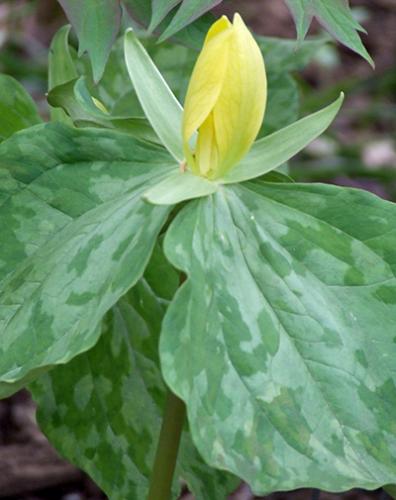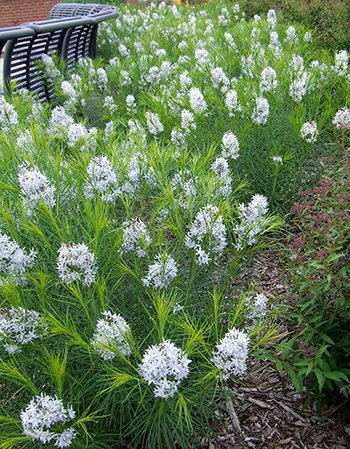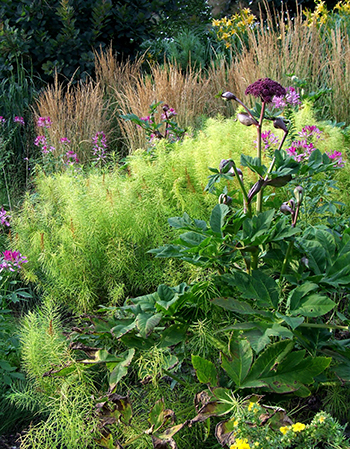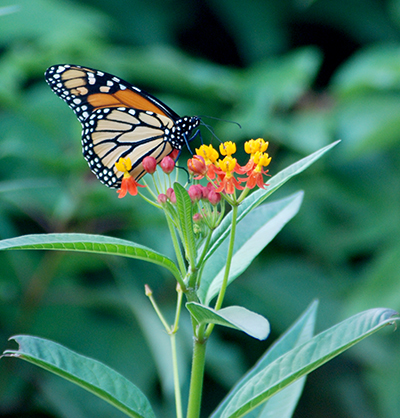Native plants provide a smart solution for your gardening challenges
A wide variety of native plants that will provide seasonal interest, color and wildlife habitat can be used in challenging landscape situations.

Colorful, eco-friendly native plants have taken center stage in recent years with garden enthusiasts and nature lovers. Herbaceous wildflowers for sunny borders or shady woodlands, lush ferns with varying heights and textures, wetland plants, trees and shrubs that claim “home” as Michigan or the greater Midwest will provide habitat for beneficial insects, pollinators, birds and wildlife.
From the wing of an airplane, one can easily notice the “patchwork quilt” effect of Michigan’s remaining natural habitat. Huge gaps exist between small patches of native meadow or woodland environments. Often, entire urban neighborhoods contain few or no native plants that provide food for many living creatures. Gardeners can get involved with aiding these beneficial organisms by choosing to plant native plants in their landscapes, gardens, beds and borders.
Smart plants – start with natives!
One may ask, “What is a smart plant?” Better put – is there a dumb plant? The answer lies in the plant’s adaptability to Michigan’s varying weather, environment and soils. Many garden catalogs list an exotic plant, one that is not native, as a garden “diva” or “water hog.” These are the plants that fall into the latter category since they take greater intervention on the part of the gardener. Needing more water, more fertilizer or more pesticides are the hallmark traits of a diva plant, but thrifty, well-adapted plants including natives are a much smarter choice for the home landscape.
Try ferns and other shade-lovers
Smart gardeners are already employing the traits of thrifty native plants. I wish I had known more about ferns in my early years of garden design. I can’t think of a plant that “does its business” underground in a more sensible way. These plants often create a dense “mat” of roots that branch off with deep, underground rhizomes. The finely-textured beauties including male fern and cinnamon fern add texture and contrast to any part-shade garden.
Ferns have the reputation of thriving in wet environments, but don’t be too quick to judge. Even the native ostrich fern and royal fern can adapt to a drier, shady border. Many ferns will also adapt to sunny conditions if there is ample moisture. Ferns like ostrich fern make a stunning texture contrast in a container too.
Show off early blooming native plants
Spring-blooming natives such as shooting star (Dodecathon media) and trillium are favorites for the moist, woodland garden. Snow white Trillium grandiflorum blooms mark the end of a cold winter and are commonly found in Michigan woodlands. Midwest natives, including yellow trillium (Trillium lutea) and red trillium (Trillium erectum), will also fare well in a home landscape. Both of these species’ ornamental qualities are quite outstanding.

In the spring, ephemerals like our native white trillium make a stunning accent in the garden. Trillium luteum has the added benefit of interesting foliage.
One of my favorite spring ephemerals, the trout lily (Erythronium americanum) features nodding, bright yellow blooms and will also grow well in a shady area that is wet or dry. Resembling a spotted trout, its mottled foliage gives this lovely plant such an odd name. Trout lilies often pop up in a natural landscape in the oddest places, sometimes very dry. We often forget that even “green” plants like the Jack-in-the-pulpit (Arisaema triphyllum) offer striking form and foliage all season long.
Choose prairie plants for sun
Sunny areas in the landscape can be enhanced with a wide variety of meadow or upland prairie natives. Known for tolerating “feast or famine” environmental conditions, these plants are often sought out to be planted in a rain garden, bio-swale or even in parking lot buffer strips. Cup plants feature bright yellow, daisy-like blooms born on very tall and sturdy stems. This is a large plant that grows up to 8 feet, lending itself well to the back of a perennial border. Insects seeking nectar and pollen enjoy all the plants in this family (Asteraceae).
If you are looking for an early summer blooming plant with silky, fine texture throughout summer and late fall, look no further than narrow-leaf blue star (Amsonia hubrechtii). This plant can be co-mingled with many other garden ornamentals and will light up the fall landscape with hues of cinnamon and peach.


If you are looking for an early summer blooming plant with silky, fine texture throughout summer and late fall, look no further than narrow-leaf blue star (Amsonia hubrechtii). During late summer, Amsonia hubrechtii shines nestled between other perennials and grasses.
The following video discusses matching native plants to your garden needs.
An article on native plants would not be complete without mentioning favorites like the bold, sun-lovers including rattlesnake master (Eryngium yuccifolium) and butterfly weed (Asclepias tuberosa). Aptly named, rattlesnake master has somewhat spiny leaves that are coarse in texture, topped by sweetly-scented spheres comprised of many tiny blooms. This plant is candy for insects seeking nectar and pollen in late summer, and it has a beauty all its own.
Whoever named butterfly weed really missed the mark, for it is no weed like I’ve ever known. Non-descript foliage surprises gardeners in their hot, sunny landscape border with cheerful clusters of intense orange blooms. The blooms last for quite a while and if you stand still long enough, you will see butterflies hovering about seeking a meal.

Species of butterfly weed (Asclepias) not only attract colorful monarchs, but their brightly colored blooms dazzle in the summer garden.
Native plant resources
If you’re not sure where to start with selecting plants, visit the MSU Native Plants and Ecosystem Services website. Look under the Regional Plant Lists section for recommendations for Michigan’s southern and northern Lower Peninsulas and the Upper Peninsula. The handy tables for wildflowers, ferns, trees/shrubs/vines and grasses/sedges/rushes identify how much sun and moisture each needs and indicates the flower color and average plant height. In the Plant Facts section of the website, there are fact sheets with pictures and notes from MSU researchers about how attractive the plant is to pollinators and to natural enemies that help control pests.
The following videos will highlight many Michigan natives as well as help explain the reasons behind design.
You can also download the Smart Gardening tip sheet on “Going native can be a smart choice for Michigan landscapes.”
The Kent County MSU Extension Grand Ideas Garden will host their annual plant sale featuring plants that solve problems on June 5-6 to support garden education in west Michigan. Join the expert team of Michigan State University Extension Master Gardeners who will help you navigate through the choices Friday, June 5 from 5-8 p.m. and again Saturday, June 6 from 9 a.m. to 1 p.m.
For more information on plants that are known to tolerate garden conditions that many of us struggle with in our home landscape, see the following articles from this series:



 Print
Print Email
Email




